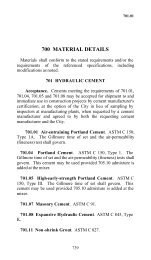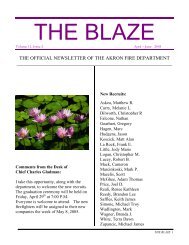Akron Water Pollution Control Station No Feasible Alternative
Akron Water Pollution Control Station No Feasible Alternative
Akron Water Pollution Control Station No Feasible Alternative
Create successful ePaper yourself
Turn your PDF publications into a flip-book with our unique Google optimized e-Paper software.
to 135% of this value. The final settling tank capacity is not constrained by the peak solids<br />
loading rate of 35 lbs./day/ft. 2 due to the typical mixed liquor suspended solids concentration of<br />
1,800-2,000 mg/l, and the 16% RAS pumping rate. Based on a maximum 1,000 gpd/sf surface<br />
overflow rate, the FSTs should be limited to a process flow of 141 MGD.<br />
“However, based on <strong>Water</strong> Environment Federation Manual of Practice <strong>No</strong>. 8<br />
(MOP 8), it would be appropriate to limit the overflow rate to 800 gpd per square<br />
foot for a 100 foot diameter tank with a ten foot side water depth (SWD). Ten of<br />
the 18 final settling tanks at the <strong>Akron</strong> WPCS have ten foot SWD…If the twelve<br />
foot deep final settling tanks were operated to the designed maximum SOR of<br />
1,000 gpd/sf and the ten foot deep final settling tanks were operated to a<br />
maximum SOR of 800 gpd/sf, a peak flow of 119 MGD may be processed (one<br />
ten foot deep unit out-of-service). Although linear regression analysis of available<br />
data suggests acceptable performance would occur near this rate, the number of<br />
data points is inadequate to provide a high confidence level for this scenario. The<br />
relatively shallow depth (10 foot sidewater depth) of ten of these tanks makes it<br />
questionable to predict performance at higher SORs. Density current baffles<br />
were recently installed to reduce upflow currents along the sidewalls. Historically,<br />
a fairly persistent pin floc problem had caused concern for the effluent TSS<br />
concentration at high SORs. Recent operational and physical improvements<br />
have diminished the pin floc problem.” (Facilities Plan 98 6 )<br />
3.3.2. Hydraulic Limitations<br />
The 1980 Facilities Plan 1 recommended operating the <strong>Akron</strong> WPCS to provide complete<br />
treatment of all flows up to a rate of 150 MGD. It is the historical understanding of the City that<br />
the 150 MGD rate included RAS flow (110 MGD wastewater plus 40 MGD RAS). All flows to<br />
210 MGD were to receive preliminary treatment, including screening and grit removal, and<br />
disinfection. The Plan provided for using the storm retention basins to store the first 10 MG of<br />
flow in excess of 150 MGD.<br />
In 1996 the plant treated an average day flow of approximately 89 MGD with 80.8 MGD average<br />
flow through the secondary treatment facility. Past experience and studies of the various<br />
treatment facilities have resulted in the <strong>Akron</strong> WPCS being operated to limit flows through<br />
primary and secondary treatment to approximately 150 MGD and 110 MGD, respectively. The<br />
purpose of this hydraulic evaluation (originally presented in the Facilities Plan 98 6 ), and in<br />
conjunction with the 1993 and 1997 stress tests and the process performance evaluation, was<br />
to study the hydraulic feasibility of processing higher flow rates through various treatment<br />
facilities.<br />
The following three general operating requirements specific to plant hydraulics are considered<br />
respective of Ohio EPA and the Recommended Standards for Wastewater Facilities 2 (Ten<br />
States Standards).<br />
• all treatment facilities shall be protected from flooding caused by the 100-year flood<br />
recurrence level in the receiving stream (Cuyahoga River);<br />
• treatment facilities shall function uninterrupted and provide adequate treatment for permit<br />
compliance when faced with the 25-year flood level in the receiving stream (Cuyahoga<br />
River); and<br />
• treatment facilities shall function adequately and provide treatment to a level meeting permit<br />
requirements with the largest unit of any treatment process out-of-service.<br />
Page 3-8







